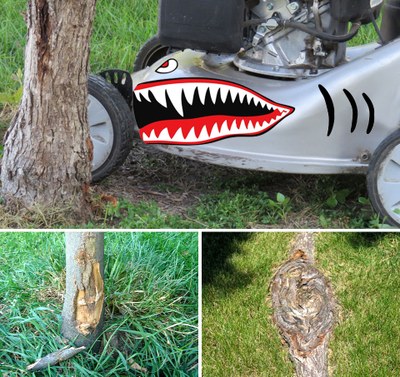Tree-Eating Sharks
It’s Shark Week in America. All week we can watch horror stories of people getting attacked by sharks:
Rodney Fox was attacked by a great white shark in Australia. He recalled, “I’m looking through the pink of the water, through my own blood, and … I see the head. Getting bigger.”
The shark bit into Rodney, ripping open his body, crushing his ribs and puncturing his lungs. Rodney required 462 stitches to seal his wounds. Ouch!
Bethany Hamilton was surfing one day in Hawaii. Before she knew it, her arm was ripped off by a tiger shark. She said, “It was about a two- to three-second period and when it ... was attacking me all I saw was like a gray blur.”
Are you scared yet? Imagine YOURSELF in a swimming pool. A trap door in the pool opens and a shark is released. The shark comes toward YOU… you can hear the water ripple as it swims … it’s rushing toward YOU… and you are helpless!
This is the way a tree feels when a lawn mower comes near. Absolutely helpless!
Every time you start your mower, every tree in your yard shudders in fear. Your mower—a machine designed to bite through plants with a sharpened steel blade—will soon be brushing against the tree’s skin.
The mower is one of the leading killers of trees in North Dakota.
Mowers attack bark, the armor of a tree. Just beneath the bark is the phloem, a precious layer where nutrients are carried from the leaves to the roots. If you expose the bark, the phloem is destroyed. If you destroy the phloem, the roots stop receiving nutrients from leaves. The roots starve and die.
If that isn’t bad enough, the wounds created by mowers are easily invaded by diseases.
How much damage to the bark can a tree withstand?
Trees generally survive if the damage is limited to 25% or less of the bark around the tree. As damage levels increase higher, the tree suffers higher levels of decay and dieback. If the bark is stripped around the entire tree, it will die. This is called girdling.
- A properly mulched tree.
Place a ring of mulch around each tree. Follow the “3-3-3 rule” (see photo). Place a ring of mulch that is at least 3 feet in diameter around the tree—even more is better. The mulch should be 3 inches deep. Keep mulch to a minimum for the first 3 inches away from the trunk. Heaping mulch against the trunk can create stem rot and provide nesting habitat for bark-biting voles.
Use wood-based mulches such as chips or shredded bark. This mulch will conserve moisture, smother weeds and enrich the soil. Wood mulch will insulate tree roots, keeping them cooler in summer and warmer in winter. Most importantly, the mulch will protect the tree from your mower!
Rock mulch is less desirable. It traps heat, accelerating bud break (and potential frost injury) in spring, as well as creating excessive heat stress in summer. Rock mulch compacts the soil and provides no nutrients.
What are you waiting for? The next shark attack is coming soon!
Written by Tom Kalb, Extension Horticulturist, North Dakota State University.
Source: Hunt, K. 2015. The 10 craziest shark attack stories of all time. www.thrillist.com/travel/nation/shark-attack-stories-bethany-hamilton-mick-fanning-and-other-survivors.
Photos were made available under Creative Commons licenses specified by the photographers: Tom Kalb, NDSU; Penman2; Joseph O’Brien, USDA Forest Service, Bugwood.org.



